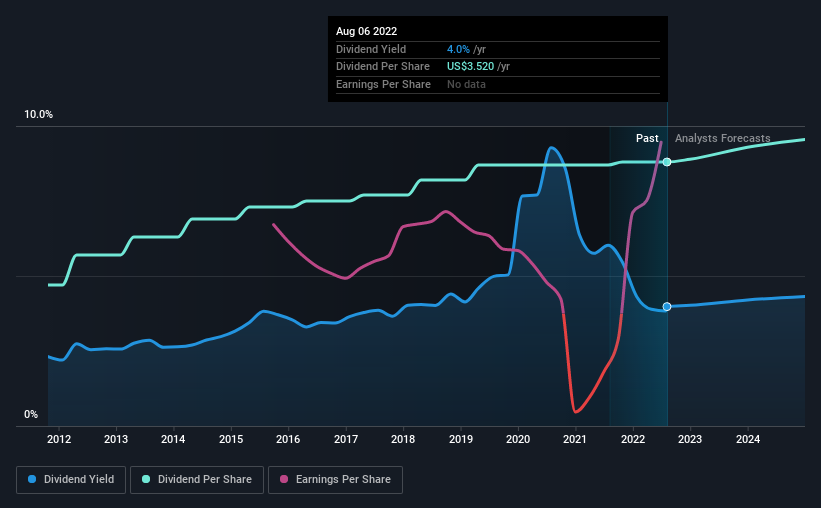Should You Buy Exxon Mobil Corporation (NYSE:XOM) For Its Upcoming Dividend?
It looks like Exxon Mobil Corporation (NYSE:XOM) is about to go ex-dividend in the next three days. The ex-dividend date is one business day before a company's record date, which is the date on which the company determines which shareholders are entitled to receive a dividend. The ex-dividend date is important because any transaction on a stock needs to have been settled before the record date in order to be eligible for a dividend. Accordingly, Exxon Mobil investors that purchase the stock on or after the 11th of August will not receive the dividend, which will be paid on the 9th of September.
The company's next dividend payment will be US$0.88 per share. Last year, in total, the company distributed US$3.52 to shareholders. Based on the last year's worth of payments, Exxon Mobil has a trailing yield of 4.0% on the current stock price of $88.45. Dividends are an important source of income to many shareholders, but the health of the business is crucial to maintaining those dividends. So we need to investigate whether Exxon Mobil can afford its dividend, and if the dividend could grow.
View our latest analysis for Exxon Mobil
Dividends are typically paid out of company income, so if a company pays out more than it earned, its dividend is usually at a higher risk of being cut. Fortunately Exxon Mobil's payout ratio is modest, at just 38% of profit. Yet cash flows are even more important than profits for assessing a dividend, so we need to see if the company generated enough cash to pay its distribution. Thankfully its dividend payments took up just 30% of the free cash flow it generated, which is a comfortable payout ratio.
It's positive to see that Exxon Mobil's dividend is covered by both profits and cash flow, since this is generally a sign that the dividend is sustainable, and a lower payout ratio usually suggests a greater margin of safety before the dividend gets cut.
Click here to see the company's payout ratio, plus analyst estimates of its future dividends.
Have Earnings And Dividends Been Growing?
Companies with consistently growing earnings per share generally make the best dividend stocks, as they usually find it easier to grow dividends per share. If business enters a downturn and the dividend is cut, the company could see its value fall precipitously. It's encouraging to see Exxon Mobil has grown its earnings rapidly, up 38% a year for the past five years. Earnings per share have been growing very quickly, and the company is paying out a relatively low percentage of its profit and cash flow. This is a very favourable combination that can often lead to the dividend multiplying over the long term, if earnings grow and the company pays out a higher percentage of its earnings.
The main way most investors will assess a company's dividend prospects is by checking the historical rate of dividend growth. Exxon Mobil has delivered an average of 6.5% per year annual increase in its dividend, based on the past 10 years of dividend payments. It's encouraging to see the company lifting dividends while earnings are growing, suggesting at least some corporate interest in rewarding shareholders.
The Bottom Line
Has Exxon Mobil got what it takes to maintain its dividend payments? We love that Exxon Mobil is growing earnings per share while simultaneously paying out a low percentage of both its earnings and cash flow. These characteristics suggest the company is reinvesting in growing its business, while the conservative payout ratio also implies a reduced risk of the dividend being cut in the future. There's a lot to like about Exxon Mobil, and we would prioritise taking a closer look at it.
In light of that, while Exxon Mobil has an appealing dividend, it's worth knowing the risks involved with this stock. Every company has risks, and we've spotted 2 warning signs for Exxon Mobil (of which 1 makes us a bit uncomfortable!) you should know about.
A common investing mistake is buying the first interesting stock you see. Here you can find a full list of high-yield dividend stocks.
Have feedback on this article? Concerned about the content? Get in touch with us directly. Alternatively, email editorial-team (at) simplywallst.com.
This article by Simply Wall St is general in nature. We provide commentary based on historical data and analyst forecasts only using an unbiased methodology and our articles are not intended to be financial advice. It does not constitute a recommendation to buy or sell any stock, and does not take account of your objectives, or your financial situation. We aim to bring you long-term focused analysis driven by fundamental data. Note that our analysis may not factor in the latest price-sensitive company announcements or qualitative material. Simply Wall St has no position in any stocks mentioned.
Join A Paid User Research Session
You’ll receive a US$30 Amazon Gift card for 1 hour of your time while helping us build better investing tools for the individual investors like yourself. Sign up here


